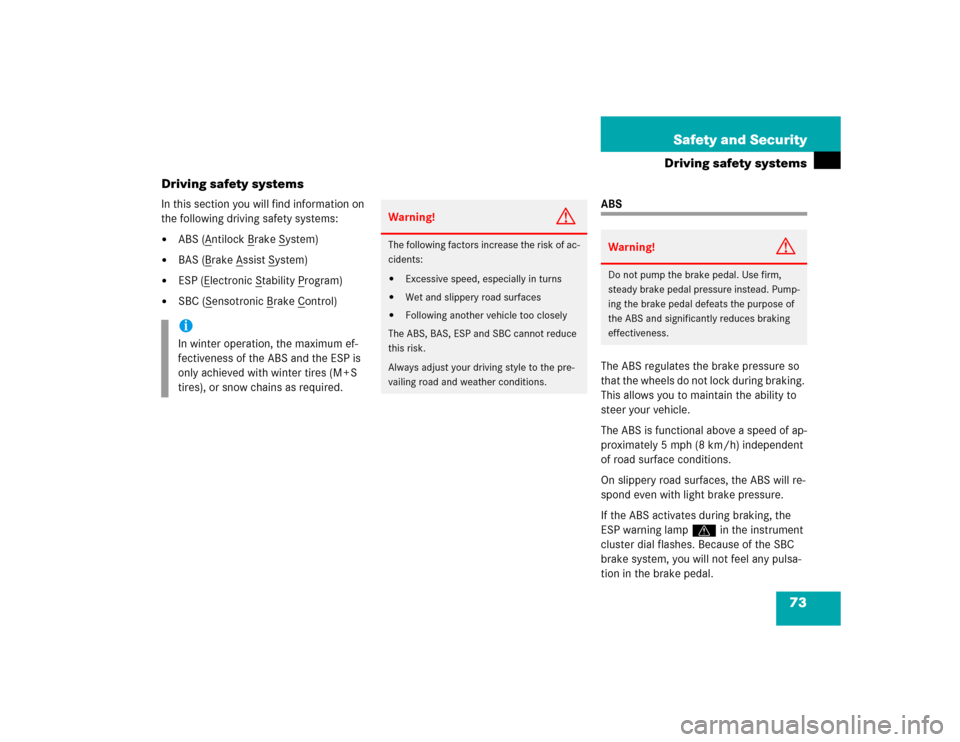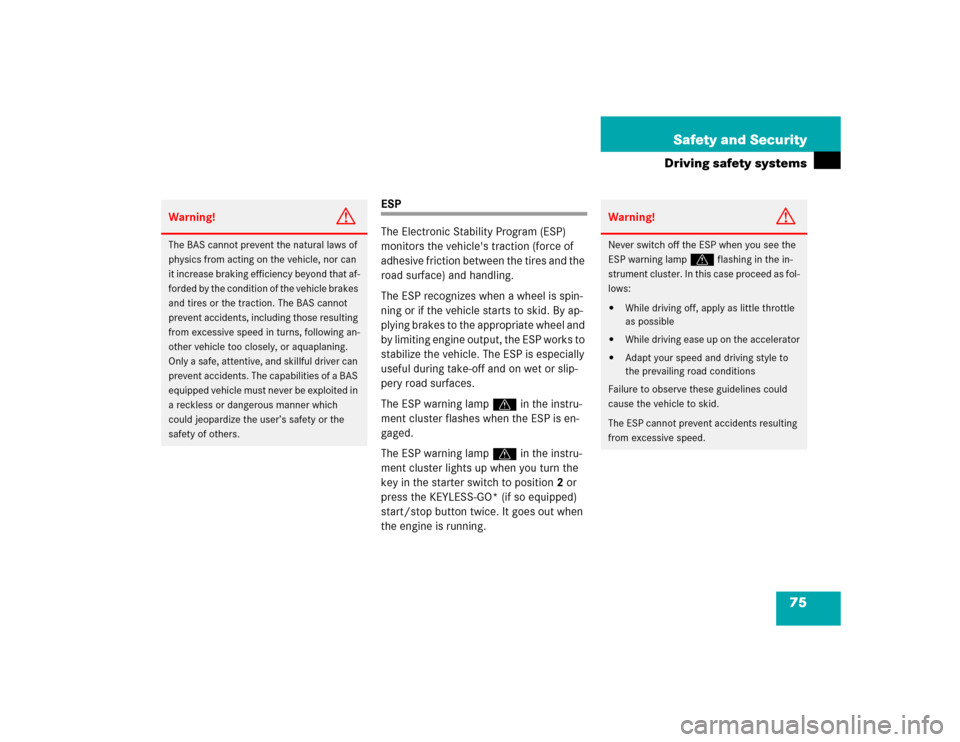Page 71 of 399
71 Safety and Security
Occupant safety
Blocking of rear door window operation
1Override switch
2Indicator lamp�
Press override switch1.
Indicator lamp 2 lights up. The rear
door windows can no longer be operat-
ed using the switches located in the
rear doors.For more information on power windows,
see the "Controls in detail" section
(
�page 184).
!Operation of the rear door windows
with the switches located on the door
control panel of the driver‘s door is still
possible.Warning!
G
Activate the override switch when children
are riding in the back seats of the vehicle.
The children may otherwise injure them-
selves, e.g. by becoming trapped in the win-
dow opening.
When leaving the vehicle, always remove the
key from the starter switch, and lock the ve-
hicle. Do not leave children unattended in
the vehicle, or with access to an unlocked
vehicle. Unsupervised use of vehicle equip-
ment can cause serious personal injury.
Page 73 of 399

73 Safety and Security
Driving safety systems
Driving safety systems
In this section you will find information on
the following driving safety systems:�
ABS (A
ntilock B
rake S
ystem)
�
BAS (B
rake A
ssist S
ystem)
�
ESP (E
lectronic S
tability P
rogram)
�
SBC (S
ensotronic B
rake C
ontrol)
ABS
The ABS regulates the brake pressure so
that the wheels do not lock during braking.
This allows you to maintain the ability to
steer your vehicle.
The ABS is functional above a speed of ap-
proximately 5 mph (8 km/h) independent
of road surface conditions.
On slippery road surfaces, the ABS will re-
spond even with light brake pressure.
If the ABS activates during braking, the
ESP warning lamp v in the instrument
cluster dial flashes. Because of the SBC
brake system, you will not feel any pulsa-
tion in the brake pedal.
iIn winter operation, the maximum ef-
fectiveness of the ABS and the ESP is
only achieved with winter tires (M + S
tires), or snow chains as required.
Warning!
G
The following factors increase the risk of ac-
cidents:�
Excessive speed, especially in turns
�
Wet and slippery road surfaces
�
Following another vehicle too closely
The ABS, BAS, ESP and SBC cannot reduce
this risk.
Always adjust your driving style to the pre-
vailing road and weather conditions.
Warning!
G
Do not pump the brake pedal. Use firm,
steady brake pedal pressure instead. Pump-
ing the brake pedal defeats the purpose of
the ABS and significantly reduces braking
effectiveness.
Page 74 of 399

74 Safety and SecurityDriving safety systemsContinuos steady brake pedal pressure
yields the advantagesprovided by the ABS,
namely braking power and ability to steer
the vehicle.
The - warning lamp in the instrument
cluster lights up when you turn the key in
the starter switch to position2 or press
the KEYLESS-GO* (if so equipped)
start/stop button twice. It goes out when
the engine is running.
More information can be found in the
"Practical hints" section (
�page 289).
BAS
The Brake Assist System (BAS) operates in
emergency situations. If you apply the
brakes very quickly, the BAS automatically
provides full brake boost, thereby poten-
tially reducing the braking distance. Apply
continuous full braking pressure until the
emergency braking situation is over. The
ABS will prevent the wheels from locking.
When you release the brake pedal, the
brakes function again as normal. The BAS
is then deactivated.
iTo alert following vehicles to slippery
road conditions you discover, operate
your hazard warning flashers as appro-
priate.
Warning!
G
The ABS cannot prevent the natural laws of
physics from acting on the vehicle, nor can
it increase braking or steering efficiency be-
yond that afforded by the condition of the
vehicle brakes and tires or the traction. The
ABS cannot prevent accidents, including
those resulting from excessive speed in
turns, following another vehicle too closely,
or aquaplaning. Only a safe, attentive, and
skillful driver can prevent accidents. The ca-
pabilities of an ABS equipped vehicle must
never be exploited in a reckless or danger-
ous manner which could jeopardize the us-
er’s safety or the safety of others.
Page 75 of 399

75 Safety and Security
Driving safety systems
ESP
The Electronic Stability Program (ESP)
monitors the vehicle's traction (force of
adhesive friction between the tires and the
road surface) and handling.
The ESP recognizes when a wheel is spin-
ning or if the vehicle starts to skid. By ap-
plying brakes to the appropriate wheel and
by limiting engine output, the ESP works to
stabilize the vehicle. The ESP is especially
useful during take-off and on wet or slip-
pery road surfaces.
The ESP warning lamp v in the instru-
ment cluster flashes when the ESP is en-
gaged.
The ESP warning lamp v in the instru-
ment cluster lights up when you turn the
key in the starter switch to position2 or
press the KEYLESS-GO* (if so equipped)
start/stop button twice. It goes out when
the engine is running.
Warning!
G
The BAS cannot prevent the natural laws of
physics from acting on the vehicle, nor can
it increase braking efficiency beyond that af-
forded by the condition of the vehicle brakes
and tires or the traction. The BAS cannot
prevent accidents, including those resulting
from excessive speed in turns, following an-
other vehicle too closely, or aquaplaning.
Only a safe, attentive, and skillful driver can
prevent accidents. The capabilities of a BAS
equipped vehicle must never be exploited in
a reckless or dangerous manner which
could jeopardize the user’s safety or the
safety of others.
Warning!
G
Never switch off the ESP when you see the
ESP warning lamp
v
flashing in the in-
strument cluster. In this case proceed as fol-
lows:
�
While driving off, apply as little throttle
as possible
�
While driving ease up on the accelerator
�
Adapt your speed and driving style to
the prevailing road conditions
Failure to observe these guidelines could
cause the vehicle to skid.
The ESP cannot prevent accidents resulting
from excessive speed.
Page 78 of 399

78 Safety and SecurityDriving safety systems
The SBC brake system is automatically ac-
tivated when you:�
unlock the vehicle with the key or the
KEYLESS-GO*
�
open the driver’s or passenger door
�
turn the key in the starter switch to
position1
�
in vehicles with KEYLESS-GO*, press
start/stop button on selector lever
once
�
depress the brake pedal
�
release the parking brake
Warning!
G
The SBC brake system requires electrical
power to operate.
A malfunction in the vehicle’s power supply
or electrical system may impair brake sys-
tem operation and switch it into its
limp-home (emergency operation) mode. In
such a case, the red brake warning lamp
(�page 291) and warning messages in the
instrument cluster (
�page 305) light up
while driving. To brake, the driver must then
apply significantly greater brake pedal pres-
sure and depress the pedal much further to
obtain the expected braking effect. If neces-
sary, apply full pressure to the brake pedal.
Brakes are only applied to the front wheels.
Stopping distance is increased!
If there is a malfunction in the SBC brake
system, we recommend that the vehicle be
transported with all wheels off the ground
using flatbed or appropriate wheel lift/dolly
equipment. A tow bar must be used if cir-
cumstances do not permit the use of the
recommended towing methods and the ve-
hicle requires towing with all four wheels on
the ground. Towing the vehicle with all four
wheels on the ground is only permissible
for distances up to 30 miles (50 km) and at
a speed not to exceed 30 mph (50 km/h).
For more information, refer to "Towing the
vehicle" (
�page 348).
Page 83 of 399

83 Safety and Security
Anti-theft systems
Arming the tow-away alarm
When you lock your vehicle, the tow-away
alarm is automatically armed after about
30 seconds.
When you unlock your vehicle, the
tow-away protection disarms automatical-
ly.
Disarming the tow-away alarm
To prevent triggering the tow-away alarm
feature, switch off the tow-away alarm be-
fore towing the vehicle, or when parking on
a surface subject to movement, such as a
ferry or auto train.The button is located on the overhead con-
trol panel.
1Tow-away alarm off button
�
Turn off the ignition and remove the
key.
�
Press button1.
The indicator lamp in the button lights
up briefly.
�
Lock your vehicle with the key or (vehi-
cles with KEYLESS-GO*) the lock but-
ton at each door handle.
The tow-away alarm remains disarmed un-
til you lock your vehicle again.
Canceling the alarm
�
Insert the key in the starter switch.
or
�
Press the Œ or ‹ button on the
key.
iYou cannot disarm the tow-away alarm
if the ignition is turned on.
Page 85 of 399
85 Controls in detail
Locking and unlocking
Seats
Memory function
Lighting
Instrument cluster
Control system
Automatic transmission
Good visibility
Climate control
Automatic climate control*
Power windows
Sliding/pop-up roof*
Panorama sliding/pop-up roof*
Driving systems
Loading
Useful features
Page 88 of 399

88 Controls in detailLocking and unlocking
Checking the batteries�
Press button‹ orŒ.
Battery check lamp5 lights up briefly
to indicate that the key batteries are in
order.Unlocking the trunk lid
You can unlock the trunk separately.
A minimum height clearance of 5.75 ft.
(1.75 m) is required to open the trunk lid.
�
Press and hold button Š until trunk
opens.
The trunk can also be opened from its in-
side in an emergency, see "Trunk lid emer-
gency release" (
�page 97).
!If you can no longer lock or unlock the
vehicle with the key, then either the
batteries in the SmartKey are dis-
charged or the key is malfunctioning.�
Check the batteries in the key
(�page 88) and replace them if
necessary (
�page 328).
or
�
Use the mechanical key to lock and
unlock the doors (
�page 327) and
the trunk lid (
�page 98) as re-
quired.
If the key is malfunctioning, contact an
authorized Mercedes-Benz Center.
!If battery check lamp5 does not light
up briefly during check, then the key
batteries are discharged.
Replace the batteries (
�page 329).
You can obtain the required batteries
at any authorized Mercedes-Benz Cen-
ter.
!The trunk lid swings upwards automat-
ically. Always make sure that there is
sufficient overhead clearance.